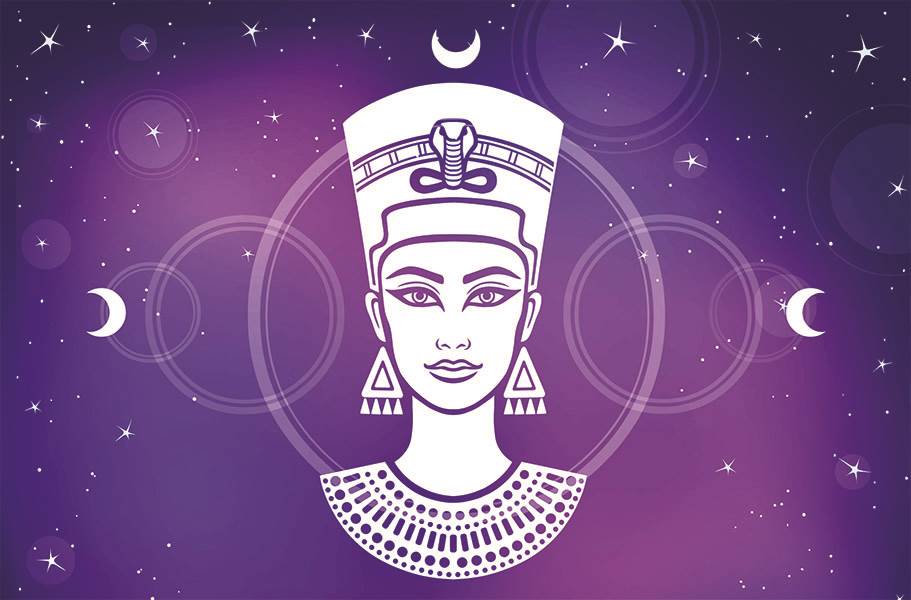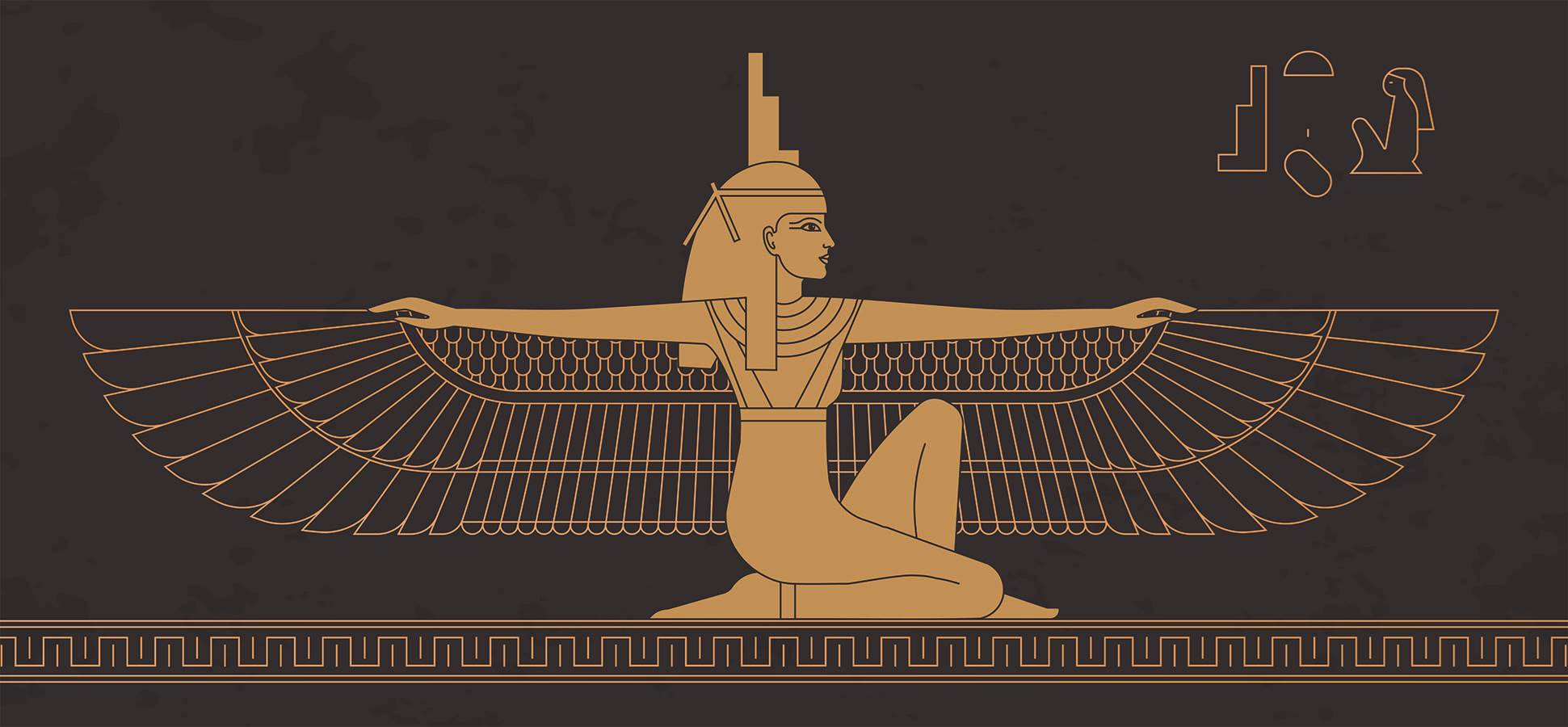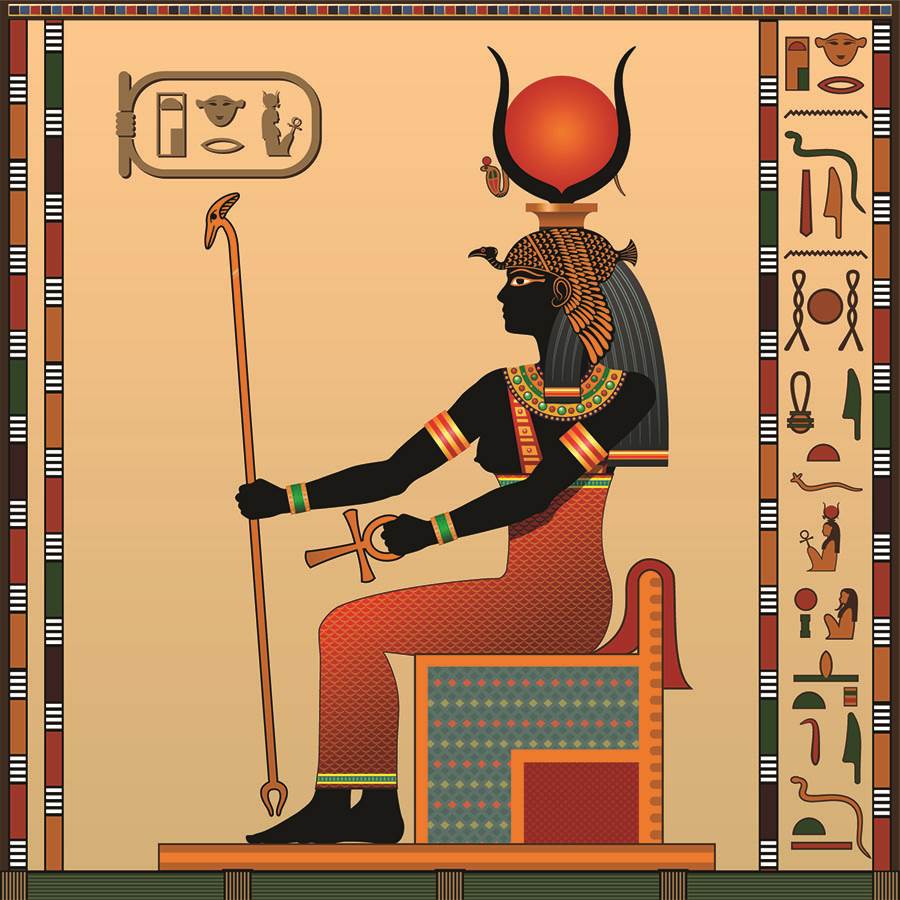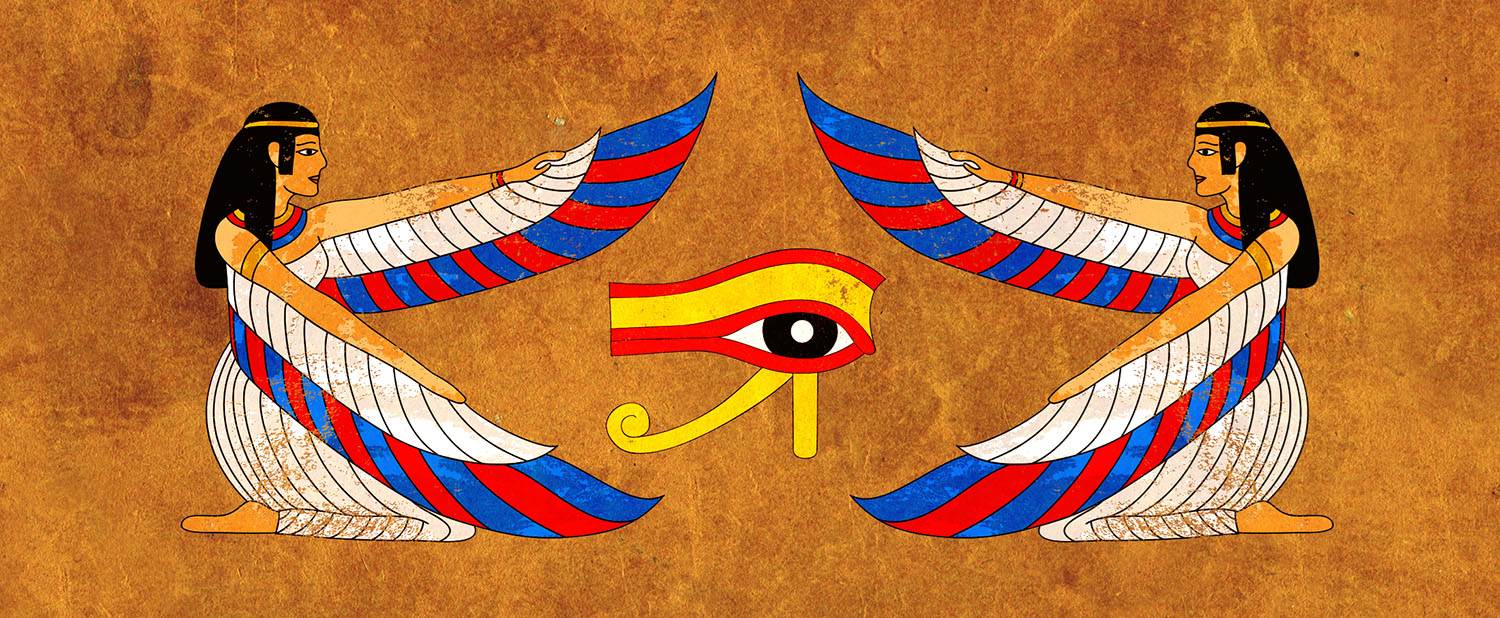Connecting with the Divine Feminine of the Goddesses of Ancient Egypt by Psychic Natasha
Date 11/6/2024
Explore More:
Goddesses Spirituality Spiritual Traditions World Cultures
A goddess of cosmetics, to whom a ritual is dedicated when putting on make-up? Temples to the female goddesses run by priestesses? Masses dancing in orgiastic bliss on the streets to divine feminine energy? What power can be discovered in the history of ancient Egyptian goddesses! From Hathor, Nephtyus, and Isis, we have so much to learn about the sacred feminine!
Let’s explore each in turn and see how their visibility and values might seep through to rebalance and re-invigorate our modern world.
Introducing Egyptian Mythology Goddesses

Nephthys, Goddess of Night and Death
First, let’s look at the Nephthys, goddess of death and decay. The personification of darkness, she was a protectress of the dead. Her name translates as Lady of the House, but her name doesn’t mean a domestic house. Rather, her name refers to Lady of the Temple Enclosure, directly connecting her with the role of priestess. She symbolizes the Gate to the Temple. Sister and wife of Set, she paired with her sister Isis in rituals surrounding funerals.
Together, Isis the Egyptian goddess of love and Nephthys protected mummies - the preserved human bodies which Egyptians drained of moisture. This embalming process was thought to preserve the home of the spirit or soul. Egyptians started this practice around 2600 BCE, during the Fourth and Fifth Dynasties. Today we can still view bodies of that time free from decay.
Ancient Egyptians linked Nephthys with mourning, night, childbirth, magic, temple rituals of protection, and beer. She was the daughter of Nut, the goddess of sky, stars, cosmos, mothers, astronomy, and the universe. The sky is usually masculine in other cultures, as in Father Sky, Mother Earth, but in the religion of the ancient Egyptians, her father Geb was the Egyptian Deity of Earth. He is the father of snakes. His laughter was thought to produce earthquakes and allow crops to grow. The ancient Egyptians often depicted him holding up Nut. In these images, her black body fills with stars against the background of the night sky.
The divine feminine healing of Nephthys was especially important in helping the spirits and souls of deceased Egyptians on their way to the afterlife. Is it any wonder that fascination with this ancient culture continues throughout today? In Western culture, the Greeks banned women’s voices in chants sung to help with the passing of the dead. This began a process where patriarchal culture wrote women out of mourning and officiating priestess roles.

Isis, Goddess of Fertility
Women today looking for reflections of strength in the divine feminine goddess Isis can find her divine feminine power a source of inspiration for personal growth and empowerment. Just like her sibling Nephthys, she was born the daughter of Nut and Geb. She had a role as a nurturing mother.
Women prayed to her for children, healing, and good health. Ancient Egyptians held her in high regard, believing she epitomized all positive feminine qualities.
Isis was a powerful sorceress, and a bringer of life and magic. She used her magical power to resurrect her brother and husband Osiris from the dead. She helped him become the god of the afterlife, and later Egypt’s first divine king. In this myth, she subsequently gave birth to his child, the falcon-headed Horus.
In Western civilization, when women with magic powers were discovered, they were burnt as witches in the Inquisition. Thus, interest in the recovery of Isis as a life-giving magical symbol continues on the part of those seeking divine feminine spirituality today.
Some say she introduced the concept of marriage to Egyptian culture, and that she taught them how to brew beer of which her sister became the goddess.
Isis is her Greek name. Her Greeks cults danced to the music of the ancient double spouted flute, the aulos. But then, the Greeks outlawed the tones of her music as the father-centered gods of mythology took over.
Her Egyptian name was Aset. This name translates to Queen of the Throne. She often wears a headdress that looks like one. She also commonly wears a vulture headdress, or a crown with horns and a sun disk. These stunning representations communicate her celestial powers and connections to the heavens.
Isis was known as Queen of the Gods, and the Mother of Pharaohs (the Egyptian rulers thought to be divine). The ancient Egyptians often bedecked her with feathers standing with spread wings. Her popularity was so great that all of Egypt worshiped her. She brought prosperity to the entire kingdom and rose to being the supreme deity.

Hathor, Goddess of Music and Transitions
Another major goddess in the Egyptian religion was the magnificent, maternal Hathor. As to origins, some myths say she came to the earth with Ra; others say she was the daughter of Nut and Ra.
A solar deity, thought of as the Goddess of the Sun, she mothered or partnered both with the sky god Horus and the Sun God, Ra. She protected Ra from his enemies. She also represented music, dance, joy, love, and sexuality.
Like Nephthys, Hathor helped deceased souls transition to the afterlife. She fed the dead when they arrived in the underworld, or land of the dead. She typified the Egyptian concept of femininity in her ability to cross boundaries between worlds.
Ancient Egyptians always depicted Hathor with either dark red or black skin.
Sometimes ancient Egyptians depicted Hathor as a cow, symbolizing her maternal and celestial side. Other times she appeared as a lioness, a cobra, or a sycamore tree. The ancient Egyptians dedicated more temples to her than to any other goddess. The sistrum, an ancient musical instrument played in her processions, helped her in the protection of pregnant women, and also when she nursed the Pharaohs.
As the Goddess of Beauty, including cosmetics, she inspired much sensuality. The ancient peoples of Egypt created beautiful jewelry in her honor. The Greeks later captured this sense in the evolution of the Hellenic goddess, Aphrodite. Some say Hathor became the Greek goddess of love.
When Horus, one of Hathor’s consorts, gave her a bracelet of 42 stars, this piece of jewelry served as an amulet against demons. For this divine feminine power of being able to repel negative forces and energy, women revered Hathor. Daily they called her down into their own lives through application of make-up and donning of jewelry to beautify and protect. By beautifying, they assured themselves safety through the connection with Hathor’s sacred divine feminine energy.

Resurgence of Interest in Goddess Spirituality
Chances are you've seen depictions of the empowered leader of Ancient Egypt's goddess feminine energy. Since 1908, directors have created at least 22 films and television dramas about Cleopatra. She succeeded in conquering both Caesar and Anthony with the sacred divine feminine archetype. Her image has seized popular imagination across continents and over the years.
Acting out of the energy of Hathor Egyptian mythology, Cleopatra brought these gruff male Roman emperors to their knees. Drawing in the goddesses, she charmed the foreign leaders into submission for the benefit of her kingdom, power, and career.
Must-sees are the productions of 1913, 1917, 1934 and 1959, and of course the 1963 version starring Elizabeth Taylor.
But the poster promoting a version in the 1920s led to scores of self-liberating First Wave women (flappers) bobbing their hair. The outburst of the Second Wave of the women's liberation movement in the late sixties and seventies created even more of a demand.
Celebrated versions later appeared in 1967, 1970, 1972, and 1974.
What does this trend in popular culture reveal? Unequal pay, restrictive legislation, and other social limitations make many modern women into second class citizens. We need empowering female images raising the specter of female strength. And so unconsciously, women as consumers found a way to connect to the effects of goddess spirituality.
Women have been reclaiming the divine feminine as producers of culture too. My experience dancing around a goddess sculpture at a women’s music festival in the 80s singing a chant that began with “Isis” was only a part of this overall timeless, universal process of the divine feminine rising. We were unleashing the power of ancient goddesses, the Egyptian among them. Reclaiming the divine feminine can inspire personal growth and empowerment, as like in this modern ritual, we harnessed the magic of the goddess within.
Wear make-up? Find your personal style? Congregate with women in reclaimed religions such as the Reformed Religion of the Goddess? Make, buy, sell, and wear jewelry that conjures the goddess? Search out a priestess? Wear feminine clothes and jewelry at work instead of the traditional black suit power clothes?
Any and all of the above. The stories and attributes of these ancient Egyptian goddesses resonate with modern seekers of female wisdom and inspiration. These goddesses served as protectors in the balance between life and death and facilitated transformation. The more time spent in goddess mythology, including the Egyptian, the more the absence of women in leadership and important political positions in the modern world, and the suppression of the female, becomes apparent.
In the face of wars, homelessness, the refugee crisis, and political and economic collapse, these goddesses have an enduring importance as symbols of harmony and equilibrium. We need goddesses such as Hathor to return us to the resonance of the celebration of the beauty of life itself.
When sought out as an advisor, I lead the caller in guided meditative visualizations; I might not say the word goddess, or the word Egyptian, but I lead clients the best I can to discover this divine feminine within. I encourage the integration of the wisdom and teachings of these goddesses into everyday life. The stories of Egyptian goddesses can inspire resilience, inventiveness, nurturing relationships, and the embracing of one’s true self.
The power of ancient wisdom is endlessly and truly informative. Like Hathor, you can be all that is best in women! Like Isis, go after your spouse by torchlight in the darkness, and reclaim your sexuality! Like Nephthys, don’t be afraid to go into the dark and search for lost pieces. Inspired by these goddesses, you can transform others and the world we live in as well as yourself.
Further Resources
My Life with Cleopatra: The Making of a Hollywood Classic: Wanger, Walter, Hyams, Joe, Turan, Kenneth: 9780345804051: Amazon.com: Books.
The Politics of Women's Spirituality: Essays by Founding Mothers of the Movement: Spretnak, Charlene: 9780385172417: Amazon.com: Books.
http://www.shira.net/egypt-goddess.htm. The Goddesses of Ancient Egypt by Shira.
https://www.youtube.com/watch?v=QWl_D79UmN0, Mysteries of the Egyptian Book of the Dead | Secrets of Ancient Egypt.
https://www.youtube.com/watch?v=HJJQX7wlrCQ. The Top 20 Egyptians Gods and Goddesses.
 Get a Reading with Natasha x4836
Get a Reading with Natasha x4836
Psychic Natasha, PhD, is an intuitive who trained with Lilydale mediums. She has a passion for divination through the body, which she believes was created by a divine force. Her interest in hand and face analysis as well as Vedic astrology drew her to India, Mexico and Argentina, where she studied with well-known readers in Varanasi, Delhi, Khahajaro, Tepotzlan and Buenos Aires. She had a shop of her own on Isla Mujeres in Mexico for eight years and has been practicing these arts as well as reading feet and the Tarot at music, theater, and yoga festivals since the mid-1980s. She reads palms and face through video chat and can help you discover your destiny or get back on course. She also works with crystals and cards through chat and the phone.
